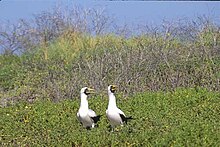Malden (island)
| Malden | ||
|---|---|---|
| NASA image of Malden Island | ||
| Waters | Pacific Ocean | |
| Archipelago | Line Islands | |
| Geographical location | 4 ° 0 '54 " S , 154 ° 55' 45" W | |
|
|
||
| length | 8 kilometers | |
| surface | 39.3 km² | |
| Highest elevation | 8 m | |
| Residents | uninhabited | |
Malden ( English Malden Island ) is an uninhabited coral island in the central Pacific Ocean , which belongs to the Line Islands of the island republic of Kiribati .
geography
Malden is located 200 km northeast of Starbuck Island , about 670 km northwest of Caroline Atoll and about 447 km south of the equator .
The island is a so-called upscale atoll , in which the lagoon is now completely enclosed by the coral ring, but has not yet dried up. In this case, the lagoon is counted as an inland lake in the land area. Malden has the shape of a triangle with two cut corners, with the sides each about seven to eight kilometers long. The area of the island, which is up to eight meters high, is 39.3 km², of which about 13 km² is accounted for by the irregularly shaped lagoon. Since the highest peaks are along the coast, the ocean can often not be seen from inside the island.
The island is almost completely surrounded by a coral reef ; landing by boat is considered difficult.
history
The atoll was discovered for Europe on July 30, 1825 by HMS Blonde under Captain George Anson Byron and named after Charles Robert Malden , who was the first to land on the island. The island was found uninhabited, but remains of an early Polynesian settlement were found. Later investigations came to the conclusion that the island must have been inhabited by about 100 to 200 inhabitants a few hundred years earlier.
Large amounts of guano were first reported in 1828 and the island was claimed by the United States after the Guano Islands Act was passed in 1856 . However, Australian companies had already started mining, which lasted until around 1927. At that time, Malden was also permanently inhabited, with a small settlement at the western end of the island. On July 12, 1979, Malden became part of the newly founded state of Kiribati with other islands of the Line Islands.
Nuclear weapons tests
Great Britain as a colonial power carried out three nuclear weapons tests on Malden from May 15 to June 19, 1957 , followed by further nuclear weapons tests on Kiritimati .
Flora and fauna
At the time of its discovery by Europeans, a large part of the interior of the island, similar to the island of Vostok , was densely covered by Pisonia trees ( Pisonia grandis ), which can reach heights of up to 20 m. However, the pisonia trees have largely disappeared due to human influences. The Ilima shrub ( Sida fallax ) is often found today . The originally occurring Polynesian rat ( Rattus exulans ) was exterminated by introduced domestic cats.
Malden Island is an important breeding area for eleven species of seabirds , such as the masked booby ( Sula dactylatra ), the red-footed booby ( Sula sula ), the banded frigatebird ( Fregata minor ) or the black tern ( Onychoprion fuscatus ).
The island was on 29 May 1975 Nature Reserve Malden Iceland Wildlife Sanctuary declared and the Wildlife Conservation Unit of the Ministry of Line and Phoenix Islands Development managed. However, there are no permanent staff on the island, so the nature reserve is difficult to monitor. In 1979 there was a fire on the island, probably caused by (illegal) visitors.
literature
- Edwin H. Bryan, Jr .: American Polynesia and the Hawaiian Chain ; Honolulu, Hawaii 1942 (Rev. ed.)
Web links
- Jane's Oceania Page - Malden Island (English)
- Malden on oceandots.com ( Memento from December 23, 2010 in the Internet Archive )
Individual evidence
- ↑ UNEP Islands (English)




